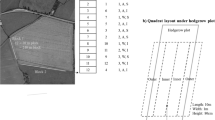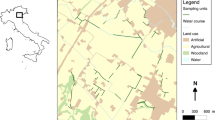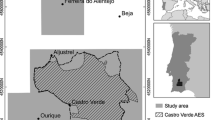Abstract
Hedgerows originated and coexist with agriculture. Their internal structure and species diversity vary widely with origin (planted, spontaneous, or remnant), farming practices in adjacent fields, and the refined art of hedgerow management. Most hedgerow species are forest-edge species, and apparently none is limited to hedgerows. Wide hedgerows composed of trees and shrubs appear to function as corridors for movement of many plants and animals across a landscape. The reduction of crop loss, by dampening pest population fluctuations with hedgerow predators, remains a hypothesis for study.
Field microclimate downwind of a hedgerow is modified about 16 times the hedgerow height (h) for evaporation, and approximately 28 h for wind speed. A turbulent wind pattern with harsher microclimate is present at 6–8 h if a second hedgerow is nearby downwind. Zones of higher crop productivity at 3- to 6-h downwind, and 2- to 6-h upwind of a second hedgerow may be expected. Overall, we expect little short-term difference in farm-field production with or without hedgerows.
Evidence suggests that hedgerow networks, and especially their mesh size (of fields), exert a major control on many major landscape fluxes. Such fluxes include animal populations, wind speed, evapotranspiration and soil desiccation, soil erosion and nutrient runoff, species movement along network lines, and movement of field species across the network. In a relatively short period, the hedgerow ecosystem, with no unique species, has attained a metastable equilibrium, which is regulated by enormous human inputs.
More than 20 economic roles of hedgerows are pinpointed. The roles, providing resources and protection of resources, are poorly known quantitatively. We conclude that hedgerows perform diverse functions for society and the farmer that are both economically and ecologically significant.
Similar content being viewed by others
Literature Cited
Alexander, W. B. 1932. The bird population of an Oxfordshire farm.J. Anim. Ecol. 1:58–64.
Ballard, J. T. 1979. Fluxes of water and energy through the Pine Barrens ecosystems. Pages 133–146in R. T. T. Forman, ed., Pine Barrens: ecosystem and landscape. Academic press, New York.
Barloy, J. 1980. Consequences sur la production vegetale agricole de l'amenagement du bocage dans l'Ouest de la France.Bull. Tech. Inf. 353-355:783–828.
Bates, G. H. 1937. The vegetation of wayside and hedgerow.J. Ecol. 25:469–481.
Baudry, J., and F. Baudry-Burel. 1978a. Contribution a la connaissance ecologique du bassin versant de la Rance. These 3eme cycle, University of Rennes, Rennes, France. 213 pp.
Baudry, J., and F. Baudry-Burel. 1978b. La mesure de la diversite spatiale: relations avec la diversite specifique, utilization dans les evaluations d'impact.Oecol. Appl. 3:177–190.
Baudry, J., and F. Burel. 1983. Les bocages: approche ecologique prealable a leur amenagement.Bull. Ecol. (in press).
Baudry, J., F. Burel, J. C. Lefeuvre, and J. Nioret. 1983. Des systems agraires en evolution: les bocages.Inst. Natl. Recherche Agron. Rapport (in press).
Blavoux, B., M. Dray, and P. Merot. 1976. Comparison des ecoulements sur deux bassins versants elementaires, bocager et“ouvert,” a l'aide du tracage par 018. Pages 153–158in Les Bocages: Histoire, ecologie, economie. University of Rennes, Rennes, France.
Brunel, E., and J. P. Cancela da Fonseca. 1979. Concept de la diversite dans les ecosystems complexes.Bull. Ecol. 10:147–163.
Bull, A. L., C. J. Mead, and K. Williamson. 1976. Bird-life on a Norfolk farm in relation to agricultural changes.Bird Study 23:163–182.
Burgess, R. L., and D. M. Sharpe, eds. 1981. Forest island dynamics in man-dominated landscapes. Springer-Verlag, New York.
Buson, C. 1979. Une approche pedologique du problem de l'epandage: characterisation hydrique des sols bruno sur schistes brioveriens de la region de Vire (Calvados). Effet des epandages de laiterie sur les sols et les eaux. These Doc. Ing., Ecole Natl. Sup. Agron. Rennes, Rennes, France. 118 pp.
Caborn, J. M. 1976. Changements du paysage et protection contre le vent. Pages 109–114in Les Bocages: histoire, ecologie, economie. University of Rennes, Rennes, France.
Cameron, R. A. D., K. Down, and D. J. Pannett. 1980. Historical and environmental influences in hedgerow snail faunas. Biol. J. Linn. Soc. 13:75–87.
Chevallier, D. 1980. Valorisation energetique des petits bois a Mardiexiex (Manche). Dipl. Agron. Approfondie. Inst. Natl. Agron. Paris, Grignon. 67 pp.
Clements, F. E. 1920. Plant indicators. Carnegie Institute, Washington, DC.
Constant, P. M., C. Eybert, and R. Mahed. 1976. Avifaune reproductrice du bocage de l'Ouest. Pages 327–332in Les bocages: histoire, ecologie, economie. University of Rennes, Rennes, France.
Damagnez, J. 1976. Bioclimatologie: rapport de synthese. Pages 105–108in Les Bocages: histoire, ecologie, economie. University of Rennes, Rennes, France.
Delelis-Dusollier, A. 1973. Contribution a l'etude des haies, des fourres preforestiers, des manteaux sylvatiques de France. These Doc. d'Etat, University of Lille, Lille, France. 146 pp.
Deveaux, D. 1976. Repartition et diversite des peuplements en carabiques en zone bocagere et arasee. Pages 377–384in Les bocages: histoire, ecologie, economie. University of Rennes, Rennes, France.
Diamond, J. M. 1972. Biogeographical kinetics: estimation of relaxation times for avifaunas of southwest Pacific islands.Proc. Natl. Acad. Sci. USA 69:3199–3203.
Dickerman, C. W. 1869. How to make the farm pay; or the farmer's book. Zeigler, McCurdy and Co., Philadelphia. 770 pp.
Dierschke, H. 1974. Saumgesellschaften im Vegetations- und Standortsgefalle an Waldrandern. Verlag Erich Goltz, Gottingen, FRG. 246 pp.
Ehanno, B. 1976. Faune entomologique du bocage breton: punaisesMiridae des vegetaux des talus. Pages 385–389.in Les bocages: histoire, ecologie, economie. University of Rennes, Rennes, France.
Eldridge, J. 1971. Some observations on the dispersion of small mammals in hedgerows.J. Zool. 165:530–534.
Esmenjand, M., J. Esteoule, and J. Guyader. 1976. Etude pedologique des differents types de talus. Pages 167–175in Les bocages: histoire, ecologie, economie. University of Rennes, Rennes, France.
Ferguson, J. A. 1916. Farm forestry. Wiley, New York. 241 pp.
Fletcher, S. W. 1950. Pennsylvania: agriculture and country life 1640–1840. Penna. Hist. Mus. Comm., Harrisburg. 605 pp.
Forman, R. T. T. 1979. The Pine Barrens of New Jersey: an ecological mosaic. Pages 569–585in R. T. T. Forman, ed., Pine Barrens: ecosystem and landscape. Academic Press, New York.
Forman, R. T. T. 1981. Interaction among landscape elements: a core of landscape ecology. Pages 35–48in Perspectives in landscape ecology. Proc. Int. Congr. Neth. Soc. Landscape Ecol., Veldhoven, 1981. Pudoc, Wageningen, The Netherlands.
Forman, R. T. T. 1983. Corridors in a landscape: their ecological structure and function.Ekol. CSSR 2:375–387.
Forman, R. T. T., and M. Godron. 1981. Patches and structural components for a landscape ecology.BioScience 31:733–740.
Geiger, R. 1965. The climate near the ground. Harvard University Press, Cambridge.
Getz, L. L., F. R. Cole, and D. L. Gates. 1978. Interstate roadsides as dispersal routes forMicrotus pennsylvanicus.J. Mammal. 59:208–212.
Guyot, G., and B. Seguin. 1976. Influence du bocage sur le climat d'une petite region. Pages 121–130in Les bocages: histoire, ecologie, economie. University of Rennes, Rennes, France.
Guyot, G., and M. Verbrugghe. 1976. Etude de la variabilite spatiale du microclimat a l'echelle parcellaire en zone bocagere. Pages 131–136in Les bocages: histoire, ecologie, economie. University of Rennes, Rennes, France.
Harmon, W. H. 1948. Hedgerows.Am. For. 54:448–450.
Helliwell, D. R. 1975. The distribution of woodland plant species in some Shropshire hedgerows.Biol. Conserv. 7:61–72.
Hooper, M. D. 1970. Hedges and history.New Scientist 31:598–600.
Hooper, M. D. 1976. Historical and biological studies on English hedges. Pages 225–227in Les bocages: histoire, ecologie, economie. University of Rennes, Rennes, France.
Hoskins, W. G. 1955. The making of the English landscape. Penguin, New York. 327 pp.
Johnson, W. C., R. K. Schreiber, and R. L. Burgess. 1979. Diversity of small mammals in a powerline right-of-way and adjacent forest in east Tennessee.Am. Midl Nat. 101:231–235.
Kasriel, R. H. 1971. Undergraduate topology. Saunders, Philadelphia. 285 pp.
Krebs, J. R. 1971. Territory and breeding density in the great tit,Parus major L.Ecology 52:2–22.
Lebeau, R. 1979. Les grands types de structures agraires dans le monde. Masson, Paris. 162 pp.
Le Clezio, P. 1976. Les ambiguites de la notion de maille optimale. Pages 551–554in Les bocages: histoire, ecologie, economie. University of Rennes, Rennes, France.
Leduc, J. P. 1979. Le role du bocage.Recherche et Nature 20:4–9.
Lefeuvre, J. L., J. Missonnier, and Y. Robert. 1976. Caracterisation zoologique: ecologie Animale (des bocages). Rapport de synthese. I.N.R.A. Pp. 315–326.
Les Bocages: histoire, ecologie, economie. 1976. University of Rennes, Rennes, France. 586 pp.
Lewis, T. 1969a. The distribution of insects near a low hedgerow.J. Appl. Ecol. 6:443–452.
Lewis, T. 1969b. The diversity of the insect fauna in a hedgerow and neighboring fields.J. Appl. Ecol. 6:453–458.
Lowe, J. C., and S. Moryadas. 1975. The geography of movement. Houghton Mifflin, Boston, 333 pp.
MacArthur, R. H., and E. O. Wilson. 1967. The theory of island biogeography. Princeton University Press, Princeton.
MacClintock, L., R. F. Whitcomb, and B. L. Whitcomb. 1977. Evidence for the value of corridors and minimization of isolation in preservation of biotic diversity.Am. Birds 31:6–16.
McAtee, W. L. 1945. The ring-necked pheasant and its management in North America. Am. Wildl. Inst., Washington, DC. 320 pp.
McDonnell, M. J., and E. T. Stiles. 1983. The structural complexity of old field vegetation and the recruitment of bird-dispersed plant species.Oecologia 56:109–116.
Merot, A., and A. Ruellan. 1980. Pedologie, hydrologie des bocages: characteristiques et incidences de l'arasement des talus boises.Bull. Tech. Inf. 353-355:631–656.
Middleton, J., and G. Merriam. 1981. Woodland mice in a farmland mosaic.J. Appl. Ecol. 18:703–710.
Naveh, Z. 1982. Landscape ecology as an emerging branch of human ecosystem science.Adv. Ecol. Res. 12:189–237.
Niering, W. A., and R. H. Goodwin. 1974. Creation of relatively stable shrublands with herbicides: arresting succession on rights-of-way and pastureland.Ecology 55:784–795.
Nip-Van der Voort, J., R. Hengeveld, and J. Haeck. 1979. Immigration rates of plant species in three Dutch polders.J. Biogeog. 6:301–308.
Oxley, D. J., M. B. Fenton, and G. R. Carmody. 1974. The effects of roads on populations of small mammals.J. Appl. Ecol. 11:51–59.
Petrides, G. A. 1942. Relation of hedgerows in winter to wildlife in central New York.J. Wildl. Manage. 6:261–279.
Pihan, J. 1976. Bocage et erosion hydrique des sols en Bretagne. Pages 185–192in Les bocages: histoire, ecologie, economie. University of Rennes, Rennes, France.
Pollard, E. 1968. Hedges. III. A comparison between the Carabidae of a hedge and field site and those of woodland glades.J. Appl. Ecol. 5:649–656.
Pollard, E. 1971. Hedges. VI. Habitat diversity and crop pests: a study ofBrevicorgne brassicae and its syrphid predators.J. Appl. Ecol. 8:751–780.
Pollard, E., M. D. Hooper, and N. W. Moore. 1974. Hedges. W. Collins Sons, London. 256 pp.
Pollard, E., and J. Relton. 1970. Hedges. V. A study of small mammals in hedges and cultivated fields.J. Appl. Ecol. 7:549–557.
Powell, E. P. 1900. Hedges: windbreaks, shelters and live fences. Orange Judd, New York. 139 pp.
Rackham, O. 1976. Trees and woodland in the British landscape. Dent., London.
Romme, W. H., and D. H. Knight. 1982. Landscape diversity: the concept applied to Yellowstone Park.BioScience 32:664–670.
Richards, P. W. M. 1928. Ecological notes on the bryophytes of Middlesex.J. Ecol. 16:267–300.
Ricou, G., and V. Lecomte. 1976. Influence de la structure bocagere sur l'entomofaune. Pages 411–417in Les bocages: histoire, ecologie, economie. University of Rennes, Rennes, France.
Roze, F. 1981. Caracterisation et evaluation de l'importance des haies lors des pre-etudes ecologiques aux operations de remembrement.In J. M. Gehu and A. Delelis-Dusollier, eds., Phytosociologie et remembrement des terres.
Saint-Girons, M. C. 1976. Les petits mammiferes dans l'ecosysteme du bocage. Pages 343–346in Les bocages: histoire, ecologie, economie. University of Rennes, Rennes, France.
Saint-Girons, H., and R. Duguy. 1976. Les reptiles du bocage. Pages 347–349in Les bocages: histoire, ecologie, economie. University of Rennes, Rennes, France.
Sands, A. 1980. Riparian forests in California: their ecology and conservation. Institute of Ecology, University of California, Davis. 122 pp.
Schlosser, E. J., and J. R. Karr. 1981. Water quality in agricultural watersheds: impact of riparian vegetation during base flow.Water Res. Bull. 17:233–240.
Schreiber, R. K., and J. H. Graves. 1977. Powerline corridors as possible barriers to the movement of small mammals.Am. Midl. Nat. 97:504–508.
Section d'Agriculture de l'Institut de France. 1822. Nouveau cours complet d'agriculture, vol. 8.
Seignobos, C. 1978. Les systems de defense vegetaux pre-coloniaux. Annales Univ. Tchad, Serie Lettres, Langues Vivantes et Sciences Humaines, Numero Special. Tchad.
Sinclair, N. R., L. L. Getz, and F. S. Bock. 1967. Influence of stone walls on the local distribution of small mammals.University of Connecticut Occasional Papers Biological Science Series 1:43–62.
The Shelterbelt Project. 1934. (Published statements by numerous separate authors.)J. For. 32:952–991.
Steavenson, H. A., H. E. Gearhart, and R. L. Curtis. 1943. Living fences and supplies of fence posts.J. Wildl. Manage. 7:256–261.
Van Eimern, J., R. Karshon, L. A. Razumova, and G. W. Robertson. 1964. Windbreaks and shelterbelts. World Meteorological Organization Technical Note no. 59. 188 pp.
Wales, B. A. 1972. Vegetation analysis of northern and southern edges in a mature oak-hickory forest.Ecol. Monogr. 42:451–471.
Webster's New Collegiate Dictionary. 1963. G. and C. Merriam, Springfield, Massachusetts. 1174 pp.
Wegner, J. F., and G. Merriam. 1979. Movements by birds and small mammals between a wood and adjoining farmland habitats.J. Appl. Ecol. 16:349–358.
Williamson, K. 1969. Habitat preferences of the wren on English farmland.Bird Study 17:30–96.
Willis, J. C. 1922. Age and area. Cambridge University Press, Cambridge.
Willmot, H. 1980. Special reference to age in Church Broughton Parish, Derbyshire.J. Ecol. 68:269–285.
Yahner, R. H. 1982. Avian use of vertical structures and plantings in farmstead shelterbelts.J. Wildl. Manage. 46:50–60.
Yoakum, J., W. P. Dasman, H. R. Sanderson, C. M. Nixon, and H. S. Crawford. 1980. Habitat improvement techniques. Pages 344–345in Wildlife management techniques manual. Wildlife Society, Washington, DC.
Author information
Authors and Affiliations
Rights and permissions
About this article
Cite this article
Forman, R.T.T., Baudry, J. Hedgerows and hedgerow networks in landscape ecology. Environmental Management 8, 495–510 (1984). https://doi.org/10.1007/BF01871575
Issue Date:
DOI: https://doi.org/10.1007/BF01871575




